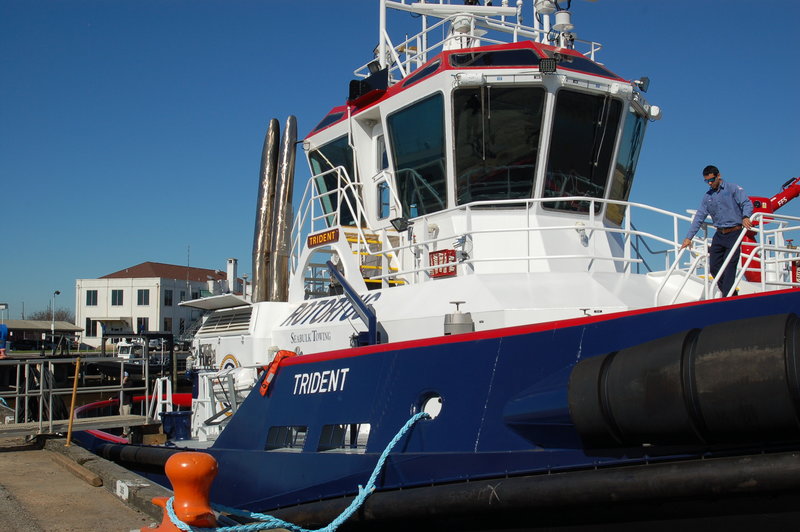I arrived at the gates of the Port of Mobile (Ala.) early Tuesday morning, where I was to meet officials from Seabulk Towing. Security at the port had tightened since the last time I was there several years ago. I was told to go to the port police department building to wait for Chris Pittman, Seabulk’s operations manager in Mobile, and Tony Caggiano, Seabulk's senior marketing manager, in from Fort Lauderdale, Fla.
Caggiano had extended an invitation to me to come to Mobile to check out the Trident, the first of three new 98'6"x43'6"x15'7" Robert Allan-designed Advanced Rotortugs (ART) for Seabulk. Built at Master Boat Builders down the road from Mobile in Bayou La Batre, Ala., the Trident represents the first time the Rotortug, which features triangular propulsion to enhance maneuverability, will be used in the U.S.
While I waited, police officials asked if I would be driving on port property. When I said yes, they asked for my driver’s license and proof of insurance. Pittman and Caggiano arrived minutes later, and I was given the necessary credentials to be on port property. “You’ll get your license back when you turn in your credentials,” the officer behind the glass said.
Fifteen minutes later we were aboard the tug. With a draft of 18'6", the Trident will be homeported in Port Everglades in Fort Lauderdale, Fla. But this week, it’s in Mobile for a workout. In addition to the crew, Seabulk’s director of technical services Russ Jones and H. Rick Groen, vice president, operations for Seacor Ocean Transport and Seabulk’s senior vice president and COO, were aboard. (Seabulk is a Seacor company.) There were quite a few others, including the tug’s captain, of course, Steve Rotert. While in the wheelhouse listening to Capt. Rotert happily explain the many benefits of the boat’s Alphatron control system, we got word that we had a job, escorting the cruise ship Carnival Fantasy to its berth alongside the Mobile Convention Center. I had been told earlier that we would be going into the river to put the new tug through its paces, but this was a real escort job. Even better.

Making up a line between the tug and the cruise ship. Ken Hocke photo.
We met up with the cruise ship as it came out of Mobile Bay into the river. The ship has its own thrusters, but we maneuvered into position as an added layer of safety. Whereas a typical stern-drive tug provides power from just two drive units, the ART has three strategically positioned azimuth propulsion units, designed to offer full redundancy and maximum maneuverability while dividing the installed power among a trio of smaller units that combine for a guaranteed bollard pull of 80 tons. More for practice than necessity, the Trident’s crew did make up a line for a short time. Once the line was brought back in, the captain turned the tug perpendicular to the cruise ship and followed along sideways as the cruise ship was making better than five knots. “This tug can go up to 8.5 knots sideways,” Groen said as people on the cruise ship lined the deck to see what we were doing.
With the Carnival Fantasy safely docked, we continued back to our berth, drawing curious eyes from other tug crews as we made our way along the river past the BAE Systems and Austal USA facilities. “This tug has no skeg. There’s no need for one on this vessel,” said Groen. “We could lose a drive unit and still continue with the two units still functioning and have a bollard pull of 51 tons.”
We got back to port and there was talk of going into the bay for exercises after lunch. But before lunch two people from Austal came aboard and we went back out into the river and ran sideways, then did 360° donuts, first one way and then the other. I felt like I should be smelling popcorn and cotton candy. It was a blast.
The Trident's main propulsion comes from three Caterpillar 3512C, Tier 3 diesel engines, producing 1,910 hp at 1,600 rpm each. The Cats connect to three Schottel SRP 1210 Z-drives. The propulsion package gives the tug a running speed of 12.5 knots. Ship’s service power comes from twin Cat engines sparking 150 kW of electricity each. On deck are two Jonrie Intertech towing winches. The forward hawser escort winch is a Series 230 outfitted with 450' of Samson 12 2-5/8"x8" HMPE rope. The aft combination towing and hawser winch is a Series 500 outfitted with 2,100' of 2.25" wire rope and 450' of Saturn 12 2-5/8"
When we returned to the dock the second time, more people from other companies hopped aboard to see the new tug. About 15 minutes later, word came down that we wouldn’t be able to go into the bay because the Trident had another job at 4 p.m. escorting a containership. The Seabulk people offered to take me out in the bay on Wednesday, but, unfortunately, I had to get back to my office in Mandeville, La.
Returning to the police station, I thanked Pittman for letting me tag along, swapped my credentials for my Louisiana driver’s license and drove through Checkpoint Charlie headed for Interstate 10.
I want to thank everyone at Seabulk and the Port of Mobile for their graciousness and hospitality. And by the way, Trident is ABS classed Maltese Cross A1, AMS, UWILD, Unrestricted Navigation. Just so you know.





